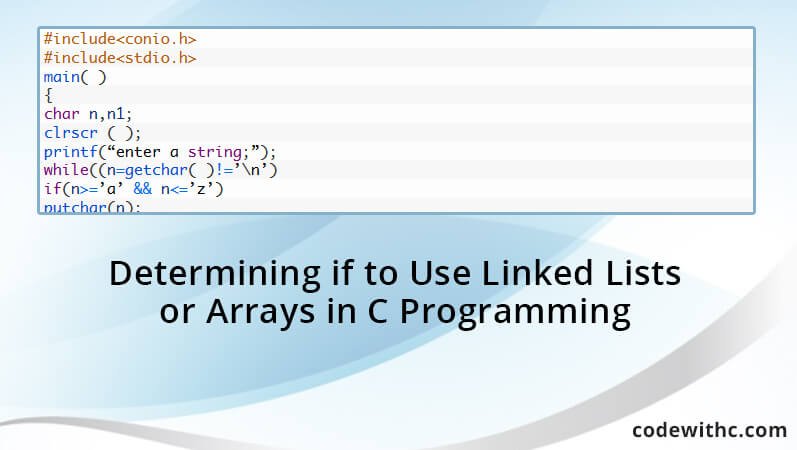Determining if to Use Linked Lists or Arrays in C Programming: A Comprehensive Guide
Oh, the age-old debate of arrays vs. linked lists in the vibrant world of C programming! ?? It’s like deciding between masala chai and filter coffee; both have their unique flavor and advantages. But as a programmer, especially when you’re navigating the bustling lanes of data structures in C, making the right choice between these two is crucial. Let’s embark on a journey to uncover the strengths and weaknesses of both, and by the end of it, you’ll have a clearer picture of when to use which. So, chai or coffee? Let’s find out! ☕️?
Why the Choice Matters
The Basics of Memory Allocation
Arrays: Arrays are contiguous blocks of memory. Imagine them as a straight line of stalls in a Delhi market, each one next to the other. Linked Lists: These are scattered chunks of memory, connected by pointers. Think of them as different food vendors in various corners of a Ramlila Mela, linked by narrow pathways.
Flexibility vs. Size
Arrays: Once declared, their size is fixed. Linked Lists: They can grow or shrink dynamically.
Performance Parameters: A Deep Dive
Insertion and Deletion
Arrays: Inserting or deleting elements, especially from the middle, can be a bit of a task. You might need to shift other elements, which can be time-consuming. Linked Lists: Since they’re connected via pointers, inserting or deleting is more straightforward. Just change the pointers, and you’re good to go!
Access Time
Arrays: Direct access to any element using the index. Super fast! Linked Lists: You’ll need to traverse from the start to access an element. Takes more time as the list grows.
Memory Efficiency
Arrays: Fixed size, so there might be wasted space if you don’t use the entire array. Linked Lists: Memory is allocated as and when needed, but remember, you’re storing the data and the pointers.
When to Use Which: Practical Scenarios ?
Predictable Number of Elements
Scenario: You know the exact number of elements. Pick: Arrays. Since the size is known, you can allocate memory efficiently.
Frequent Additions/Deletions
Scenario: Your data structure will have many insertions or deletions. Pick: Linked Lists. They shine in such situations as they can quickly adapt to changes.
Memory Considerations
Scenario: Memory is a constraint. Pick: It’s a toss-up! Arrays might waste some space, but linked lists use extra memory for pointers. Analyze the specific scenario to decide.
The Final Verdict: Arrays or Linked Lists?
Alright, it’s decision time! Just like choosing between a spicy paneer tikka or a juicy chicken kebab, the choice between arrays and linked lists boils down to your specific needs. Consider the operation frequency, memory constraints, and the number of elements to make an informed decision.
Both linked lists and arrays can be used in storing linear data of the same type, but each has some advantages and disadvantages over the other.
At what conditions whether to use linked lists or arrays in C Programming
Linked ListsLinked lists are preferred when the size of the arrays needs to be dynamic, that is, when you do not know the number of elements or items that will be in the list. For the arrays, the size of the array must be known in advance and the allocated memory storage is equal to the upper limit on the number of array’s elements.
Linked lists are most preferred over the arrays when there is no need for random access to any of the elements.
Linked lists are preferred where there is need to insert or delete data elements with ease. It is more difficult for you to add new elements in an array. This is because you have to shift the existing elements in order for you to create a room for the elements being inserted. For instance, if you have a sorted list of ages in an array age[]=[23, 31, 37, 43, 56, 75] and you need to insert a new age 29, then you must move all the elements after 23 for you to maintain the sorted order of the list.
ArraysArrays are always preferred when you need random or indexed access to the data elements.
Arrays are used when memory is a concern. When the arrays are filled up, they usually use less memory than the linked lists.
It’s most appropriate to use arrays when you need to fast iterate through all the elements in a sequence. You just need to use the math pointer on the array in order to access each element.
Arrays are preferred over the linked lists whereby you know the number of elements in advance and therefore you are able to make correct memory allocations for the data.
In Closing, Dancing to the Beat of Data Structures ??
Data structures are the backbone of efficient software applications. Whether you pick arrays or linked lists, remember that understanding the underlying principles is key. It’s like mastering the steps of a classical dance; once you know the basics, you can choreograph your own sequence, creating a harmonious blend of elegance and efficiency.
So, the next time you find yourself at the crossroads of arrays and linked lists in C, take a deep breath, recall the insights from this guide, and stride forward confidently. After all, in the grand theater of programming, every choice, every line of code, contributes to the final performance.
